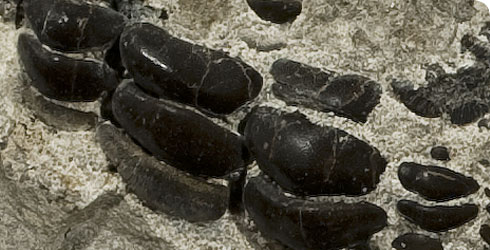Taxonomy
The body of the Zechstein shark, Wodnika striatula, is about 1m long and streamlined with a strong tail, showing that it could swim fairly fast.
These sharks have a number of distinct features.
Fin spine
Distinctive supporting spine at the anterior edge of each dorsal fin, which probably acted as a cutwater to improve swimming performance.
Most living sharks no longer have these fin spines, although some have retained them, including:
- heterodontids - bullhead sharks
- some squalids - dogfish sharks
- chimaeras - rat-fish
Flattened bean-shaped teeth
The shark's teeth were aligned close to each other, forming dental plates in the upper and lower jaws. The shark used these against each other to crush and grind its food.
Wodnika probably fed on reef animals such as the free-swimming nautiloid Peripetoceras which is found in the same strata as Wodnika.
Similar types of teeth are also found in some modern sharks, such as the bullhead sharks whose food is shellfish and other hard-bodied animals.
Usually only the teeth and spines of Wodnika (and most other fossil sharks) are preserved as fossils, but recently a complete specimen was acquired by the Museum showing full details of the shark.
Claspers
In living sharks, the males have clasper organs at the base of the pelvic fins and these are used during mating to fertilise the eggs inside the female. Fossil remains of the clasper organs of Wodnika have also been found.
The Museum’s complete specimen is a female because there are no claspers present.
